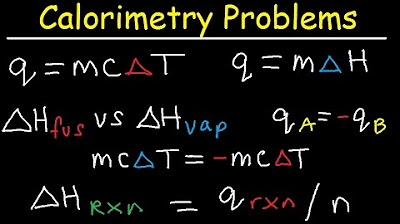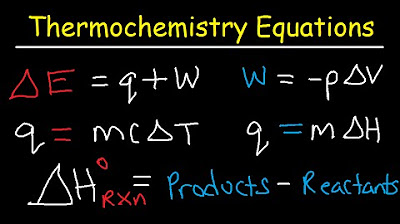How Much Thermal Energy Is Required To Heat Ice Into Steam - Heating Curve Chemistry Problems
TLDRThis educational video script explores the energy required to heat 100 grams of ice at -30°C to steam at 300°C. It breaks down the process into five stages, each requiring different amounts of energy (q1 to q5). The script explains how to calculate these values using specific heat capacities and enthalpy changes for ice and water, emphasizing the high energy cost of vaporization. The total energy for the process is calculated to be 347.3 kilojoules, highlighting that 65% of this energy is used for vaporization. The video also discusses the practical implications of this knowledge, such as the cooling effect of sweat evaporation and the distinction between endothermic and exothermic processes.
Takeaways
- 🔍 The problem involves heating 100 grams of ice from -30°C to steam at 300°C, which requires calculating the energy for various stages.
- 📊 The process includes five energy calculations: q1 (heating ice to 0°C), q2 (melting ice to water), q3 (heating water from 0°C to 100°C), q4 (vaporizing water to steam), and q5 (heating steam from 100°C to 300°C).
- 🌡 The specific heat capacity for ice is 2.03 J/g°C, and for water is 4.18 J/g°C, while steam has a specific heat capacity of 2 J/g°C.
- 🧊 q1 is calculated using the formula m*c*ΔT, where m is mass, c is specific heat capacity, and ΔT is the change in temperature.
- 💧 q2 and q4 are associated with phase changes and are calculated using the formula n*ΔH, where n is moles and ΔH is the enthalpy change per mole.
- ♨️ The enthalpy of fusion for water is approximately 6 kJ/mole, and the enthalpy of vaporization is about 40.7 kJ/mole.
- 📐 To find q2 and q4, grams are first converted to moles using the molar mass of water (18 g/mole), then multiplied by the respective enthalpy values.
- 🔢 For q3 and q5, the temperature change (ΔT) is used to calculate the energy required using the specific heat capacities of water and steam.
- 🔥 The majority of energy (65%) is required for vaporization (q4), highlighting the high energy cost of converting liquid to gas.
- 🌡️ The total energy required for the entire process is the sum of q1, q2, q3, q4, and q5, which is 347.3 kJ.
- ⚠️ The process is endothermic, requiring energy input, and understanding the direction of temperature change is crucial for determining whether the process is endothermic or exothermic.
Q & A
What is the total energy required to heat 100 grams of ice from -30°C to steam at 300°C?
-The total energy required for this process is 347.3 kilojoules.
What are the five energy values (q values) that need to be calculated for the process described in the script?
-The five q values are: q1 - energy to raise the temperature of ice from -30°C to 0°C, q2 - energy to melt ice into liquid water, q3 - energy to heat liquid water from 0°C to 100°C, q4 - energy to vaporize liquid water into steam, and q5 - energy to heat steam from 100°C to 300°C.
What is the specific heat capacity of ice and how is it used in the calculation of q1?
-The specific heat capacity of ice is 2.03 joules per gram per Celsius. It is used in the calculation of q1 with the formula m * c * ΔT, where m is the mass (100 grams), c is the specific heat capacity (2.03 J/g°C), and ΔT is the change in temperature (30°C).
How is the enthalpy of fusion for water used in calculating q2?
-The enthalpy of fusion for water, which is about 6 kilojoules per mole, is used in calculating q2 by first converting grams of ice to moles using the molar mass of water (18 g/mol), and then multiplying the moles by the enthalpy of fusion.
What is the specific heat capacity of liquid water and how does it apply to q3?
-The specific heat capacity of liquid water is 4.18 joules per gram per Celsius. It is used in the calculation of q3 with the same formula m * c * ΔT, where the change in temperature is from 0°C to 100°C.
What is the enthalpy of vaporization and how is it used in calculating q4?
-The enthalpy of vaporization is 40.7 kilojoules per mole. It is used in calculating q4 by converting the mass of water to moles and then multiplying by the enthalpy of vaporization.
What is the specific heat capacity of steam and how is it used in the calculation of q5?
-The specific heat capacity of steam is 2 kilojoules per gram per Celsius. It is used in the calculation of q5 with the formula m * c * ΔT, where the change in temperature is from 100°C to 300°C.
Why does the vaporization of liquid water into steam require a significant amount of energy?
-Vaporization requires a significant amount of energy because it involves a phase change from liquid to gas, which is energetically costly. In the case of water, this energy is represented by the enthalpy of vaporization.
How does the process of sweating cool down the human body?
-Sweating cools down the body through the process of evaporation. As sweat (water) evaporates from the skin, it takes away thermal energy, thus cooling the body. This is an effective cooling process because a large amount of thermal energy is released during evaporation.
What is the significance of the direction of temperature change in determining whether a process is endothermic or exothermic?
-The direction of temperature change is crucial because if the system is going from a low temperature to a high temperature, energy is being absorbed (endothermic process), and the final answer for energy change (q) should be positive. Conversely, if going from high to low temperature, energy is being released (exothermic process), and q should be negative.
What percentage of the total energy is required for the vaporization of liquid water into steam in this process?
-Approximately 65 percent of the total energy is required for the vaporization of liquid water into steam, as calculated by the ratio of 226.1 kilojoules (q4) to the total energy of 347.3 kilojoules.
Outlines
🔥 Energy Calculation for Heating Ice to Steam
This paragraph discusses the process of calculating the energy required to heat 100 grams of ice from -30°C to steam at 300°C. It introduces the concept of heating curves and cooling curves and explains the steps involved in the process, including raising the temperature of ice, melting ice to water, heating water to its boiling point, vaporizing water into steam, and finally heating the steam. The energy required for each phase change (q1, q2, q3, q4, q5) is calculated using specific heat capacities and enthalpy values. The enthalpy of fusion for water is given as 6 kJ/mole, and the enthalpy of vaporization as 40.7 kJ/mole. The calculations for q1 and q3 are demonstrated with specific heat capacities for ice and liquid water, and the phase changes (q2 and q4) are calculated using the formula n times delta H. The total energy required for the entire process is the sum of these individual energy values.
💧 Detailed Calculation of Energy for Phase Changes
This paragraph provides a detailed calculation of the energy required for each phase change in the process of heating ice to steam. It starts with converting grams of ice to moles to calculate the energy needed to melt the ice (q2) using the enthalpy of fusion. The calculation for heating liquid water from 0°C to 100°C (q3) is then explained using the specific heat capacity of liquid water. The energy required to vaporize water into steam (q4) is calculated similarly, using the moles of water and the enthalpy of vaporization. The final calculation for heating steam from 100°C to 300°C (q5) uses the specific heat capacity of steam. The total energy for the process is found by summing q1, q2, q3, q4, and q5, highlighting that the majority of energy is used in vaporization. The paragraph concludes with the significance of this energy in cooling processes, such as sweating, and the importance of considering the direction of temperature change when calculating energy in endothermic and exothermic processes.
⚠️ Considerations for Endothermic and Exothermic Processes
The final paragraph emphasizes the importance of understanding the direction of temperature change when calculating energy in heating and cooling processes. It clarifies that if the process is from a low temperature to a high temperature, it is endothermic and requires energy input, resulting in a positive value. Conversely, if the process is from a high temperature to a low temperature, it is exothermic, releasing energy from the system, and the value should be negative. This distinction is crucial for correctly interpreting and calculating the energy changes in thermal processes.
Mindmap
Keywords
💡Heating Curve
💡Cooling Curve
💡Enthalpy of Fusion
💡Enthalpy of Vaporization
💡Phase Change
💡Specific Heat Capacity
💡Endothermic Process
💡Exothermic Process
💡Molar Mass
💡Thermal Energy
💡Evaporation
Highlights
The energy required to heat 100 grams of ice from -30°C to steam at 300°C is calculated using a heating curve.
The process involves five stages: heating ice, melting ice to water, heating water to 100°C, vaporizing water to steam, and heating steam to 300°C.
Q1, Q2, Q3, Q4, and Q5 represent the energy required for each stage.
Q2 and Q4 are associated with phase changes and can be calculated using n times delta H.
Q1, Q3, and Q5 are related to temperature changes and are calculated using m c delta T.
The enthalpy of fusion for water is approximately 6 kJ/mole, and the enthalpy of vaporization is 40.7 kJ/mole.
Q1 is calculated as 6090 Joules for heating ice from -30°C to 0°C.
Conversion of grams to moles is necessary for calculating Q2 and Q4.
Q2 is approximately 33.3 kJ, the energy required to melt 100 grams of ice.
The specific heat capacity of liquid water is 4.18 J/g°C, used for calculating Q3.
Q3 is 41800 Joules, or 41.8 kJ, needed to heat water from 0°C to 100°C.
Q4 is calculated as 226.1 kJ, the energy required to vaporize liquid water into steam.
The specific heat capacity of steam is 2 J/g°C, used for calculating Q5.
Q5 is 40000 Joules, or 40 kJ, needed to heat steam from 100°C to 300°C.
The total energy for the entire process is 347.3 kJ.
Vaporization of liquid water into steam accounts for the majority of the energy used.
Evaporation of sweat is an effective cooling process due to the high energy required for vaporization.
The process of heating ice to steam at 300°C is endothermic, requiring energy input.
In a cooling curve, the process would be exothermic, releasing energy.
Transcripts
Browse More Related Video

Calorimetry Problems, Thermochemistry Practice, Specific Heat Capacity, Enthalpy Fusion, Chemistry

Specific heat, heat of fusion and vaporization example | Chemistry | Khan Academy

Latent Heat of Fusion and Vaporization, Specific Heat Capacity & Calorimetry - Physics

Endothermic and Exothermic Reactions

Thermochemistry Equations & Formulas - Lecture Review & Practice Problems

Endothermic and Exothermic Reactions With Potential Energy Diagrams
5.0 / 5 (0 votes)
Thanks for rating: